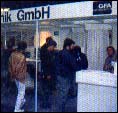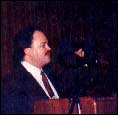News, Notes & Quotes
BY STEPHEN MORTIMER, START CONTRIBUTING EDITOR
Fat Bits
- Apple Computer has taken a major move toward improving its customer relations by providing a one-year warranty with its computers. Previously, the warranty period was 90 days, the same span of time that Atari currently has established.
- In other Apple news, the Mac IIfx was first shown in March. While Atari still, as of press time, has not released its 16MHz TT, the fx features a 40MHz 68030, 68882 floating-point coprocessor and a 32K static RAM cache. The high speed of the unit and its $9,000 price tag places it firmly in the workstation market. The unit features four dedicated ASIC I/O processors designed to enhance efficiency by managing low-level tasks.
Inside Atari
This month, there was good and bad news from Atari. First, the good news: Positive corporate earnings for the fourth quarter of 1989 were released in March. Net sales for the quarter were $170.6 million with net income of $5.7 million or 10 cents per share. Compared to 1988, sales were up $18 million while net income was down $3.6 million. For the entire year of 1989, sales were $423.6 million with net income of $4 million or seven cents per share. This compares to a net loss in 1988 of $84.8 million on sales of $452.2 million.
As of the end of 1989, the sale of Federated Group's assets was completed. Atari's more positive earnings are a result of the sale and the introduction of the Portfolio and Lynx. Sales of the ST and PC line grew, while sales in the U.S. video-game market decreased overall. European sales increased in all categories.
The bad news was that Atari Corp. (U.S.) laid off 15 percent of its workforce on March 16, 1990. Most of the staff reductions were in low- end positions at Atari, many of which were in the accounting department. Research and development staff were not affected since the division is not contained in Atari Corp. (U.S.), but in another division of Atari Corp. Mead Ames-Kline, president of Atari U.S., commented that the layoffs are part of a restructuring of the organization to make it stronger and more efficient. Ames-Kline stated that Atari is currently adding employees and is in the process of building a stronger sales and marketing department.
According to news reports, Atari is interested in purchasing an old Commodore factory in Philadelphia in order to produce LCD screens for its portable systems.
The CeBIT 1990 show held in Hannover, West Germany, gave the public a long look at Atari's upcoming product line (see European Report). For the Portfolio, five ROM cards were displayed. A new version of the Lynx, the Mark II, will have a slightly smaller screen and be without the left-handed controls. Finally, it was announced that there will be three versions of the TT. The TT030/2, TT030/X and TTX have more power and expandability. The entry-level system will have 2MB of RAM, a VME bus, with Ethernet and Unix version 5.31 available as options.
LaserJet III Debuts
Hewlett-Packard has begun shipping their LaserJet III, the latest in their popular line of laser printers. The price has been set at $2,395--$300 less than the series II.
HP's Resolution Enhancement Technology smooths out the printer's 300 dpi (dots per inch) output so that it is of much higher quality than any other 300 dpi printer on the market. The R.E.T. achieves its results by placing smaller dots, moving dots and changing the size of dots on the page to create a smoother, sharper image. The LaserJet III also features PCL 5 with its fully scaleable and rotateable fonts with Postscript quality graphics capabilities. Another advance the LaserJet III has over its predecessors is an almost 50 percent decrease in the time required to print pages of graphics. The eight pages per minute text speed is still the same. One megabyte of RAM comes standard with the printer, compared with 512K for the series II.
HP offers a $695 Postscript language cartridge and a $275 Appletalk interface as optional add-one. For more information, contact Hewlett- Packard at 19310 Pruneridge Ave., Cupertino, CA 95014, (800) 752-0900.
If you have a hot tip let us know at News, Notes & Quotes, START Magazine, 544 Second Street, San Francisco, CA 94107
European Report
Atari at CeBIT 9O
The CeBIT show in Hannover is now officially the largest computer show in the world. Several factors have contributed to this, with the recent opening of Eastern Europe and the proximity of the unified market in 1992 tipping the scales. This year, CeBIT (March 21-28), was host to more than 3,500 exhibitors from over 40 countries with a total number of attendees easily surpassing the 500,000 mark.
Third-Party Hardware
Most exhibitors at the Atari booth displayed improved versions of their existing products.
One company that managed something new was SED-DOC with their Silent Drive hard drive. Besides being very quiet, the drive is removable. The disks range in capacity from 80M to 250M and the same box will also accept removable floppy and tape-cartridge drives. SED-DOC also showed Ctree Server, an accessory for distributed database applications that run across different systems (Apple, VAX, etc.) on a local area network.
 |
| The Atari booth at CeBIT 90 was buzzing with ex- citement. |
The most impressive hardware on display was Maxon's MGE II interface to their high resolution, large screen color monitors. With MGE II an ST owner can now also drive an array of impressive Matrix monitors. Depending on the model, the monitors range from 14 to 21 inches and can display up to 16 million colors.
IBP has been tearing STs apart and reassembling them as rack-mountable industrial-control computers for years. The MSI 190 is an example, sporting a 800 x 600 resolution with 256 colors. MSP 190v is an AC/DC portable drawing on either 12 or 24 volts.
Fischer Teschnik makes what can best be described as "electronic Legos." On display was a new version of their computer controlled robot arm. The complete system is comprised of software, a hardware interface and the arm itself.
BioNet 100 by Biodata is a network running on a number of different configurations. With BioNet 100, an ST user can attain access to MS/DOS, Unix, DEC, NFS, Novell and TCP/IP systems.
Omikron, who wrote ST BASIC for Europe, ventured into hardware with their Copystation, a professional disk copier. The hopper takes up to 100 disks with automatic master recognition. The device reads a write-protected disk and then copies it to all subsequent floppies until another write-protected disk is encountered. For the rest of us, Omikron showed Easy Base, a database with fast search (0.2 seconds for 1,000 addresses) and Small Chart for graph plotting.
 |
| Sam Tramiel shows off the Lynx at the develop- er's conference. |
Third-Party Software
GFA, the granddaddy of German ST companies, was present in force. GFA BASIC 3.5e lets you use STE specific features such as hardware scrolling. The same program runs on all machines by adapting itself accordingly and there is now a new library with extended sound and graphic commands. Converter-to-C translates GFA BASIC source into C. GFA Assembler, the integrated development package, is now up to version 1.5.
Calamus SL is the color version of the well-known desktop publishing program, that supports full cyan, yellow, magenta and black color separation. DMC, in cooperation with Atari Germany, showed the package, but a release date has not been set.
1st_Card by LogiLex is a Hypercard-like expert system sporting artificial intelligence. Graphics, text and buttons are all easily linked with the built-in editor.
Application Systems Heidelberg showed a monochrome game called Esprit. The stylish ASH is better known for its line of professional software such as the Signum word processor.
Tommy Software, the sound and graphic wizards from Berlin, were true to form with a finished version of Megapaint II Professional, a combined pixel/vector drawing package, and music/MIDI programs, SoundMerlin and SoundMachine.
TmS, another graphic programming giant, showed TmS Cranach, an image-processing system that supports 24-bit color pictures on large-screen multisync monitors. Its older brother TmS Cranach Studio is the professional version with pictures of up to 40MB and a 3D simulator. TmS 2.5 converts pixel drawings to vector graphics.
Technobox showed their professional Drafter and CAD/2 programs. Already translated into English, these are professional tools aimed at designers and architects.
On the music front, most software houses went to the simultaneously held Frankfurt music fair. However, Roland's Tentrax sequencer and Steinberg's Cubase MIDI recording software were shown at Hannover. C-LAB Software exhibited their Notator Alpha which converts music to notes in real time and the Aura music education program.
Richter Computer showed Sherlook, a powerful character-recognition program that supports both monochrome and color scanners and recognizes up to eight fonts automatically. Also at the Richter stand was Chili, a sophisticated video digitizer that works with 65,000 colors. Mixing any two video signals, it lets you define the "see through" window in any regular or irregular shape down to a single pixel.
CCD, best known for Tempus editor, nudged their new Tempus_Word word processor-cum-DTP package up another notch to version 0.91 with a full-blown version 1.0 due soon.
Weide Elektronik, famous for their RAM expansions and other hardware add-one, are venturing into software. Address Direct is a database written specifically for mail-order companies. It supports both networks and GDOS, while the mail merge is possible with Tempus, 1st_Word and Calamus documents.
Advanced Applications SPC Modula-2 is now up to version 2.0 and supplied on five disks. IDA is an integrated, Adimens compatible, multitasking database.
Borland, synonymous with C on the PC, demonstrated Turbo C 2.0 (complete C development environment) and Turbo Debugger (source level) for the ST. At present, there are no plans to translate these into English as Borland believes there is no ST market outside Germany.
The Dusseldorf show is scheduled for August 24-26.